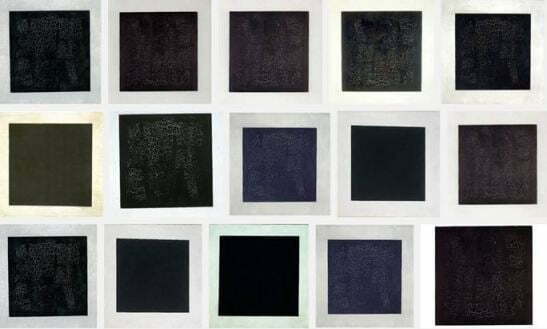
This weekend I went to the Whitechapel Gallery in London for its new exhibition, Adventures of the Black Square. This marks the 100th anniversary of Kazimir Malevich’s epoch-making painting ‘Black Square’, which was exhibited in Petrograd at the Last Futurist Exhibition of Paintings 0.10. The Whitechapel show celebrates a century of abstract art and its relation to society from that inaugural confrontational moment.
Malevich’s painting was the cornerstone of his Suprematist ideas, which advocated an art based on geometrical forms that did not relate in anyway to the objects of life. Aside from the art theory and history, the great thing about ‘Black Square’ is that it annoys people. It is ultimate statement for those who believe that modern art is a con, a joke played upon the gullible and the pretentious. It doesn’t say ‘admire me’; instead it’s a poke in the eye. It’s one of those great confrontational moments in twentieth-century art, alongside John Cage’s 4’33”, Andy Warhol’s Empire, Ornette Coleman’s The Shape of Jazz to Come and Lou Reed’s Metal Machine Music. They represent the end of the road for their art forms – except that the road in each case still carries on.
I had expected the exhibition to be a set of variations on the theme of the black square, but it is far more various and interesting than that. Its aim is to show how the artworks “symbolise Modernism’s utopian aspirations and breakdowns”, and what you get is a journey through a hundred years of art taking on the world with a new language and both winning and losing the battle as its strategies become absorbed by the world that it seeks to reflect and confront.
So you get rooms chaotically disporting every kind of abstract and abstract-inspired image, each trying to deconstruct what it is that we see. There is lots of political art; stridently designed manifestos for movements long since past. There are photographs, sculptures, paintings animations and textiles. There is an extraordinary geographical diversity, providing an important lesson that the revolution in art was not confined to a few European names from the more well-worn art books. We do see Mondrian, Moholy-Nagy and Joseph Albers, but there were so many that were new to me – Hélio Oiticica, Lyubov Popova, Nazgol Ansarinia, Clay Ketter, Anni Albers – and I was mightily impressed at the knowledge of the curators who pulled all this material together, knowing what to find and where to find it. Weaving its way through the geography and the history is the square (black, white, red, whatever) as an occasional but insistent motif – like a placard without words, telling us to see what it alone has to say.
It’s an exhibition in which film and video play a prominent part. I enjoyed watching Fernand Léger’s Ballet Mécanique (1924) for what must be the umpteenth time, but the chief thrill for me was seeing Lis Rhodes’ Notes from Light Music (1976), a 25-minute version of a larger work (Light Music), and a classic of avant garde film that (shame on me) I’d not heard of, let alone seen, before now. Brilliantly constructed, it presents the patterns of film strips in ever-changing hypnotic cascades of black and white lines, accompanied by the buzzing sounds you set when you run a film with an audio track through the sound heads of a Steenbeck. It was the sights and sounds of film of itself.

I was also delighted by a video piece Aztec Stadium (2010), by Melanie Smith, of a Mexican stadium, in which hundreds of children bore cards above their heads which if everything were synchronised properly form would some large picture. But in Smith’s film nothing ever synchronised properly. The cards were askew, the composite pictures malformed, the people distracted. It showed the chaos beneath the will to create order. It is funny and thoughtful and knowing. And among the images, several of which relate to Mexican national history (to which an electric guitar plays a Mexican marching song), is a recreation of Malevich’s ‘Red Square’ painting.
This is a show that knows what it is doing.
There are times when only abstract art will do. They are certainly times when one no longer wants a painting to portray an object, for a song to have a tune, for a film to tell a story. One simply wants the thing of itself. I have lost patience with many narrative films, or least I do not value them too highly. Instead I turn to patterns of light, finding them to be more truthful. Likewise black squares, and red squares and white squares. They represent the ultimate (the Whitechapel exhibition makes much of artists’ striving towards Utopia). There is no need for further statement once they have been said.
But then the road carries on.